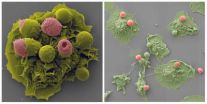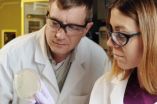(Press-News.org) New research published in The Lancet HIV shows that polydrug use is common among HIV-positive men who have sex with men (MSM) [1] and is strongly linked to sex without a condom (condomless sex).
This is the largest questionnaire study of people living with HIV in the UK, accounting for about 5% of all HIV-diagnosed MSM in the UK. The findings show that half of MSM surveyed had used recreational drugs at least once in the previous 3 months [2]. About half of those who used drugs took three or more different types of drugs, while roughly a fifth said they had used five or more different drugs in the past 3 months. Condom use was markedly lower with increasing polydrug use. For example, over three-quarters of participants who said they had used five drugs or more in the past 3 months also reported condomless sex, compared with less than a quarter of those who reported no recent drug use.
"Our findings show that polydrug use and condomless sex are closely linked in HIV-positive MSM in the UK, and that polydrug users are likely to be a group at increased risk of transmission of HIV and other sexually transmitted infections (STIs)", explains lead author Ms Marina Daskalopoulou from University College London in the UK. [3]
"The majority of these men would not consider or self-refer to traditional harm reduction services. Our findings highlight the need for cross-agency collaboration between HIV treatment and drug support organisations to provide tailored services for HIV-positive MSM who use recreational drugs, and with national HIV and STI prevention programmes to address recreational drug use." [3]
The study collected self-reported data on the drug use and sexual behaviour of 2248 MSM with HIV during 2011-2012 who were enrolled as part of the ASTRA study. All men were aged 18 years or older and attending eight HIV outpatient clinics in the UK.
Increasing number of drugs used was linked to increasing prevalence of sex that could pose a risk of transmission of HIV or other STIs. For example, recent users of five or more drugs were far more likely than those with no recent drug use to have sex without a condom (78% vs 24%); to have condomless sex with a partner of HIV-negative or HIV-unknown status (25% vs 10%); and to have sex with a higher risk of transmitting HIV (16% vs 4%; having condomless sex with a partner of HIV-negative or HIV-unknown status if the participant is not on antiretroviral treatment, has detectable viral load, or another recent STI).
However, the authors point out that only a minority (15%) of HIV positive MSM reported condomless sex with a partner of HIV-unknown or HIV-negative status, and fewer (7%) reported higher-HIV-risk condom-less sex.
Writing in a linked Comment, Associate Professor Martin Holt, from the Centre for Social Research in Health at The University of New South Wales in Australia points out that, "Only (7%) of the 2248 MSM included in the analysis reported such high-HIV-risk sex. This finding is heartening, and suggests that most HIV-positive MSM take care to prevent HIV transmission. Only a small proportion, it seems, need assistance in negotiating sex, drugs, and HIV treatment… A culturally appropriate evidence-based response is needed to help reduce harm in the UK without further sensationalising the issue.
INFORMATION:
The Lancet HIV is a new journal launched in September 2014 and will build on The Lancet journals' rich history of publishing HIV/AIDS research to provide a reliable foundation for advocacy and for programmatic and political change. The journal publishes research articles, linked commentary, and correspondence related to previous content. The journal accepts clinical, epidemiological, operational, and implementation research submissions, unifying these disciplines across a single vision for the health of those living with HIV. See http://www.thelancet.com/hiv for more details.
Notes to Editors:
This study was funded by the National Institute for Health Research.
[1] MSM includes gay and bisexual men as well as those who have sex with men but do not identify themselves as gay or bisexual.
[2] Recreational drugs included: acid (lysergic acid diethylamide, LSD), magic mushrooms, anabolic steroids, cannabis (marijuana), cocaine (coke), crack, codeine, methamphetamine (crystal meth), ecstasy (E), GHB (liquid ecstasy) or GBL, heroin, ketamine (K), Khat (chat), mephedrone, morphine, opium, amyl nitrites (poppers), amphetamine (speed), and erectile dysfunction drugs sildenafil (Viagra) and tadalafil (Cialis).
[3] Quotes direct from author and cannot be found in text of Article.
The Lancet HIV: High rates of recreational drug use among HIV-positive gay and bisexual men in the UK strongly linked with condomless sex
2014-09-08
ELSE PRESS RELEASES FROM THIS DATE:
The Lancet Respiratory Medicine: Benralizumab for chronic obstructive pulmonary disease and sputum eosinophilia
2014-09-08
Chronic obstructive pulmonary disease (COPD) is associated with eosinophilic airway inflammation in 10–20% of patients. Benralizumab, a monoclonal antibody, has been shown to decrease the number of blood and sputum eosinophils. In this trial of 101 patients with COPD whether benralizumab reduces the number of acute exacerbations was investigated. Benralizumab was found to be no more effective at preventing acute COPD exacerbations than placebo overall. However, the authors conclude that subgroup analyses suggest more research into the use of benralizumab in patients with ...
Dynamic duo takes out the cellular trash
2014-09-07
LA JOLLA—In most of the tissues of the body, specialized immune cells are entrusted with the task of engulfing the billions of dead cells that are generated every day. When these garbage disposals don't do their job, dead cells and their waste products rapidly pile up, destroying healthy tissue and leading to autoimmune diseases such as lupus and rheumatoid arthritis.
Now, Salk scientists have discovered how two critical receptors on these garbage-eating cells identify and engulf dead cells in very different environments, as detailed today in Nature Immunology.
"To ...
Platelet-like particles augment natural blood clotting for treating trauma
2014-09-07
A new class of synthetic platelet-like particles could augment natural blood clotting for the emergency treatment of traumatic injuries – and potentially offer doctors a new option for curbing surgical bleeding and addressing certain blood clotting disorders without the need for transfusions of natural platelets.
The clotting particles, which are based on soft and deformable hydrogel materials, are triggered by the same factor that initiates the body's own clotting processes. Testing done in animal models and in a simulated circulatory system suggest that the particles ...
Why age reduces our stem cells' ability to repair muscle
2014-09-07
Ottawa, Canada (September 7, 2014) — As we age, stem cells throughout our bodies gradually lose their capacity to repair damage, even from normal wear and tear. Researchers from the Ottawa Hospital Research Institute and University of Ottawa have discovered the reason why this decline occurs in our skeletal muscle. Their findings were published online today in the influential journal Nature Medicine.
A team led by Dr. Michael Rudnicki, senior scientist at the Ottawa Hospital Research Institute and professor of medicine at the University of Ottawa, found that as muscle ...
Rethinking the basic science of graphene synthesis
2014-09-07
A new route to making graphene has been discovered that could make the 21st century's wonder material easier to ramp up to industrial scale. Graphene -- a tightly bound single layer of carbon atoms with super strength and the ability to conduct heat and electricity better than any other known material -- has potential industrial uses that include flexible electronic displays, high-speed computing, stronger wind-turbine blades, and more-efficient solar cells, to name just a few under development.
In the decade since Nobel laureates Konstantin Novoselov and Andre Geim proved ...
Targeting the protein-making machinery to stop harmful bacteria
2014-09-07
One challenge in killing off harmful bacteria is that many of them develop a resistance to antibiotics. Researchers at the University of Rochester are targeting the formation of the protein-making machinery in those cells as a possible alternate way to stop the bacteria. And Professor of Biology Gloria Culver has, for the first time, isolated the middle-steps in the process that creates that machinery—called the ribosomes.
"No one had a clear understanding of what happened inside an intact bacterial cell," said Culver, "And without that understanding, it would not be ...
Continuing Bragg legacy of structure determination
2014-09-07
Over 100 years since the Nobel Prize-winning father and son team Sir William and Sir Lawrence Bragg pioneered the use of X-rays to determine crystal structure, University of Adelaide researchers have made significant new advances in the field.
Published in the journal Nature Chemistry today, Associate Professors Christian Doonan and Christopher Sumby and their team in the School of Chemistry and Physics, have developed a new material for examining structures using X-rays without first having to crystallise the substance.
"2014 is the International Year of Crystallography, ...
Ultraviolet light-induced mutation drives many skin cancers, Stanford researchers find
2014-09-07
A genetic mutation caused by ultraviolet light is likely the driving force behind millions of human skin cancers, according to researchers at the Stanford University School of Medicine.
The mutation occurs in a gene called KNSTRN, which is involved in helping cells divide their DNA equally during cell division.
Genes that cause cancer when mutated are known as oncogenes. Although KNSTRN hasn't been previously implicated as a cause of human cancers, the research suggests it may be one of the most commonly mutated oncogenes in the world.
"This previously unknown oncogene ...
Ultra-thin, high-speed detector captures unprecedented range of light waves
2014-09-07
New research at the University of Maryland could lead to a generation of light detectors that can see below the surface of bodies, walls, and other objects. Using the special properties of graphene, a two-dimensional form of carbon that is only one atom thick, a prototype detector is able to see an extraordinarily broad band of wavelengths. Included in this range is a band of light wavelengths that have exciting potential applications but are notoriously difficult to detect: terahertz waves, which are invisible to the human eye.
A research paper about the new detector ...
Researchers discover a key to making new muscles
2014-09-07
La Jolla, Calif., September 7, 2014 -- Researchers at Sanford-Burnham Medical Research Institute (Sanford-Burnham) have developed a novel technique to promote tissue repair in damaged muscles. The technique also creates a sustainable pool of muscle stem cells needed to support multiple rounds of muscle repair. The study, published September 7 in Nature Medicine, provides promise for a new therapeutic approach to treating the millions of people suffering from muscle diseases, including those with muscular dystrophies and muscle wasting associated with cancer and aging.
There ...




